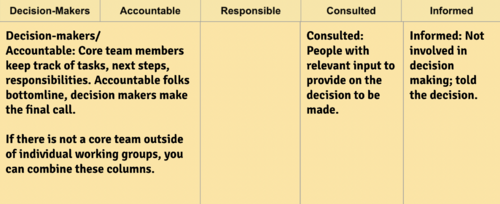DARCI decision making framework
The following includes content from the HUB's structure workshop offering.
The DARCI framework separates out who needs to be involved in decisions and at what level with regards to specific projects or group issues.
To many activists, this might seem like a corporate thing (it come from the business world) but it is actually a good way to make the decision making process clear to everyone! What's key here is to separate big picture or fundamental issues where everyone needs to be consulted and votes on decisions from smaller ones, where a set group can make decisions after consulting a set group of people and then informing others.
Overall, this model prevents the need for consultation from everyone throughout the whole process which drags a decision on. *Note this model is suggested for groups under 50 people.*

The above DARCI model has been modified by the HUB for activist purposes.
|
Decision Makers and Accountable |
Those at the ‘core’ or at the heart of a working group.
|
|
In activist and organizing circles, we could probably eliminate the ‘responsible’ category to simplify. | |
| Consulted |
Directly affected and/or knowledge keepers who can provide input on the decision to be made |
| Informed |
Not involved in the decision making but are informed on what the group came to. |
Other things to consider:
- Post a chart of all DARCI assignments in the team workspace (electronic or physical) helps keep everyone sharp on their accountabilities.
- This system does not imply hierarchy. These roles can rotate in a flattened organization.
Example DARCI (after roles selected upon group discussion):
|
|
Decision makers | Accountable | Consulted | Informed |
| Stop the pipeline campaign | Rachel | Raphael |
Ron River |
Rotary club |
Decision making can follow various forms of pure or modified consensus. See our other pages related to decision making:
- Consensus decision making 101
- Consensus decision making (suggestions for small groups)
- Modified consensus decision making (suggestions for large and small groups)
If you have any suggested revisions or additional resources to share related to the above content, please email them to kenzie@lehub.ca.
